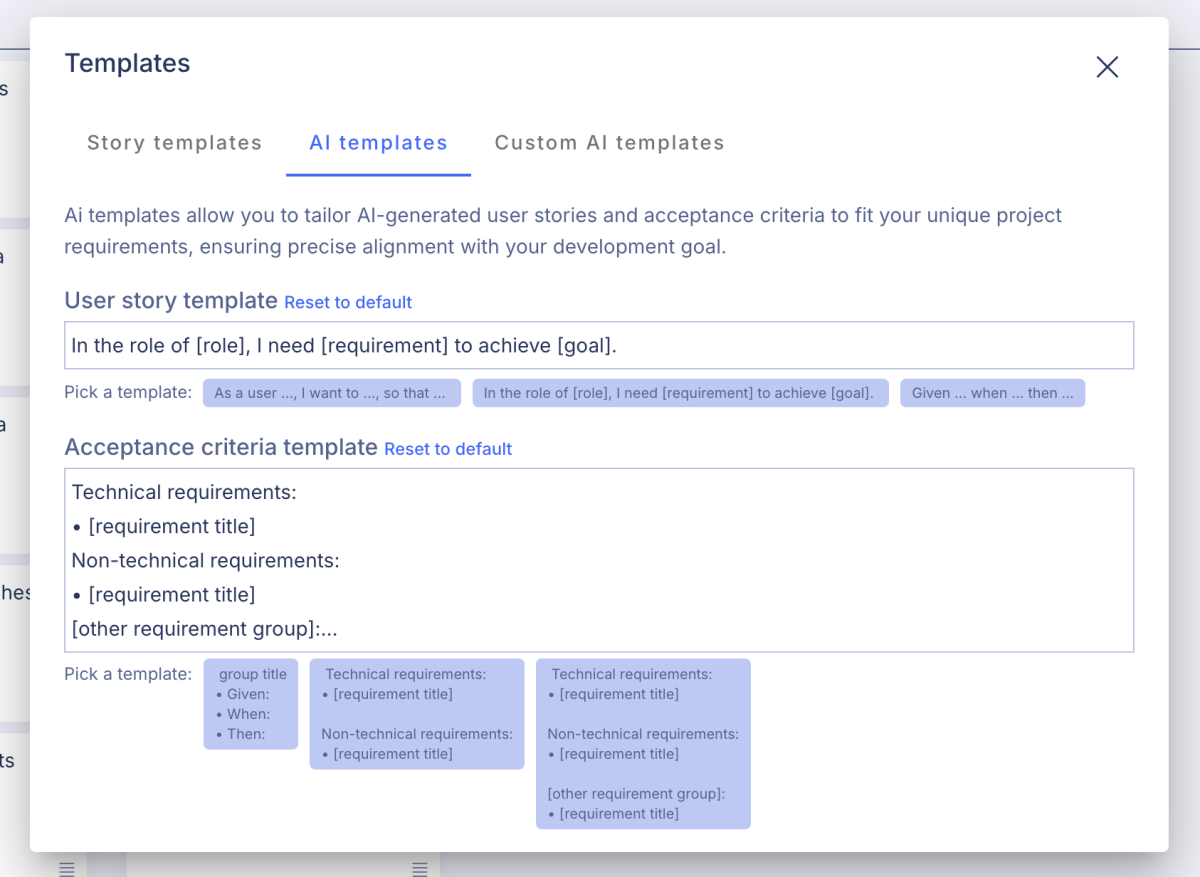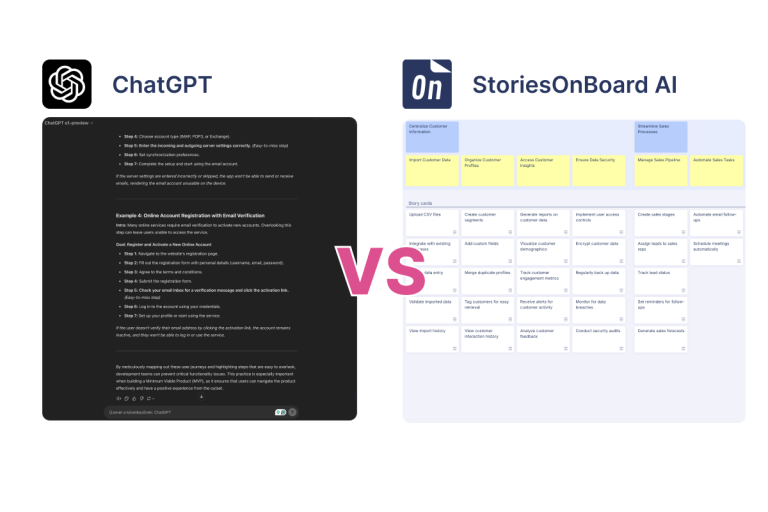In the fast-paced world of product development, effective backlog management is crucial for aligning teams, prioritizing tasks, and delivering value to users. With the rise of artificial intelligence, tools like ChatGPT and AI-powered story mapping are transforming how teams approach this essential process.
While ChatGPT offers a versatile, conversational interface for brainstorming and idea generation, AI-powered story mapping tools provide a structured framework for seamlessly creating and managing backlog items. This article explores the strengths and limitations of both approaches, helping teams make informed decisions about which tool best suits their backlog-building needs.
Context
ChatGPT and StoriesOnBoard AI handle the process differently regarding context management in story mapping. With ChatGPT, every time you open a new thread, you essentially start from scratch. This means you must repeatedly provide essential information about what a story map is, how your backlog operates, details about your product, key features, and target user personas.

While ChatGPT can maintain context within a single conversation to some extent, it tends to forget the initial details as the discussion progresses. This requires you to frequently remind the AI of the foundational information, which can become tedious and disrupt your workflow, especially for complex projects that rely on a deep understanding of various elements.
In contrast, StoriesOnBoard AI offers a more efficient approach to context management. The initial setup prompts you to input all necessary product details, including how your story mapping process works, specific product information, key features, and target user personas.

Moreover, StoriesOnBoard AI is specifically trained in the principles of story mapping, ensuring it not only understands your project’s unique requirements but also leverages best practices to enhance the effectiveness of your story mapping process.
This fundamental difference highlights why StoriesOnBoard AI may be a more practical solution for teams seeking a cohesive and efficient approach to context management in story mapping.
General experience
Significant differences become apparent when comparing the general user experience of ChatGPT with StoriesOnBoard AI for story mapping.
ChatGPT operates through a conversational chat interface, meaning that every piece of information generated by the AI needs to be manually copied and pasted into your backlog one item at a time. This item-by-item approach can be time-consuming and inefficient, especially when dealing with large or complex projects.

Additionally, even if you provide samples or specific instructions on how you want the results formatted, ChatGPT may not consistently adhere to these guidelines. It can easily forget or overlook your preferences, leading to outputs that may not align with your expectations. For instance, you might require concise item titles or detailed user story descriptions. Still, ChatGPT’s responses can vary in style and length, often including unnecessary filler text that doesn’t add value to your backlog.
In contrast, StoriesOnBoard AI is designed with story mapping in mind, offering a more structured and efficient workflow. Unlike ChatGPT’s fragmented approach, StoriesOnBoard AI understands exactly what needs to be written and where it should be placed within your backlog. This precision eliminates the need for repetitive copying and pasting, as the AI generates backlog items directly in the correct format and location.

This tailored experience saves time and ensures that your backlog remains organized and coherent, enhancing overall productivity and project management efficiency. StoriesOnBoard AI provides a more seamless and user-friendly experience for teams focused on effective story mapping by eliminating the inconsistencies and inefficiencies associated with a chat-based interface.
Actual backlog
Using ChatGPT’s chat-based interface, interactions primarily focus on generating new backlog items based on user requests. However, this approach overlooks the items that have already been manually added to the backlog.

Additionally, all AI-generated results and ideas are stored within the chat history, making it difficult for the AI to differentiate between what has been added to the backlog and what has been skipped or ignored. To keep the AI up-to-date, you must repeatedly copy and paste the entire backlog into each new chat session to provide the AI with the necessary context.

This disrupts the workflow and increases the risk of errors and inconsistencies, especially as the backlog grows in size and complexity.
In contrast, StoriesOnBoard AI is designed to see the entire backlog. This approach ensures that the AI is always aware of the current state of the backlog, preventing duplication of efforts and ensuring that new suggestions are seamlessly integrated into the existing structure. This not only saves time but also enhances the accuracy and relevance of the AI’s contributions to the story mapping process.
Result format
The format of the results generated by AI tools plays a crucial role in the efficiency and effectiveness of story mapping. When using ChatGPT, interactions occur within a chat window, leading to responses that vary significantly in style, length, and structure. This variability means that each response might require additional effort to trim and adjust the output to fit the desired format for your backlog.

For instance, if you need concise item titles or detailed user story descriptions, ChatGPT might not consistently meet these specifications, often including filler text or deviating from the expected structure. T
In contrast, StoriesOnBoard AI is designed to deliver results in a consistent and structured format explicitly tailored for story mapping. The AI uniformly provides all necessary specifications, such as acceptance criteria and user story descriptions. This consistency eliminates additional formatting, allowing users to integrate AI-generated content into their backlogs seamlessly without extra effort.

Moreover, StoriesOnBoard AI offers customization options, enabling teams to adjust the output format better to suit their needs. Whether you require a particular template for user stories or specific fields for acceptance criteria, StoriesOnBoard AI can be configured to deliver results that precisely match your preferred structure.
This level of customization ensures that the AI-generated content fits seamlessly into your existing workflow, enhancing productivity and maintaining the integrity of your story mapping process.
Collaboration
Collaboration is a cornerstone of effective story mapping, enabling teams to collaborate seamlessly towards common goals.
With ChatGPT’s chat-based interface, collaboration can become fragmented. When one team member establishes how the AI should respond and sets the context for a project, these settings are confined to that specific chat thread. If another team member opens a new thread to contribute, the previously defined context and instructions are lost, requiring them to start from scratch.
Although it is possible to share conversation histories, integrating this information into a new thread is cumbersome and inefficient.
In contrast, StoriesOnBoard AI is designed to support unified collaboration effortlessly. All team members work on the same backlog within the platform, ensuring everyone can access the same AI knowledge and context from the outset.
Continuous discovery and evidence-based prioritization
Modern product teams are moving to continuous discovery—decisions driven by live customer signals, market feedback, and product analytics that stay linked to your story map. Don’t treat research as a phase; keep collecting evidence and let it shape backlog items and priorities in real time.
ChatGPT can summarize feedback fast, but insights sit in chat threads and lose traceability across sessions. AI-powered story mapping keeps evidence attached to cards, groups themes across inputs, and links suggestions to outcomes (such as OKRs), so teams see not just what to build, but why.
- Pull support tickets, interviews, reviews, and analytics events into the map as linked evidence.
- Auto-tag user needs and jobs-to-be-done, dedupe similar requests, and surface unmet opportunities.
- Prioritize with RICE/ICE-style scoring and confidence indicators backed by cited sources.
- Generate testable hypotheses and lean experiments per card, with clear success metrics.
- Close the loop by feeding delivery results back into the evidence base to refine future suggestions.
Summary
In the evolving product development landscape, selecting the appropriate AI tool for backlog management can significantly influence a team’s efficiency and success. This comparison between ChatGPT and StoriesOnBoard AI underscores several critical differences that can help teams determine which tool best fits their needs.
ChatGPT, with its flexible conversational interface, excels in brainstorming and idea generation but falls short in maintaining consistent context and structured output. Each new thread requires users to repeatedly provide essential project details, disrupting workflow and increasing the potential for errors, especially in complex projects. Additionally, the variability in ChatGPT’s responses often necessitates extra manual adjustments to fit the desired format, making the process time-consuming and inefficient.
On the other hand, StoriesOnBoard AI offers a more streamlined and specialized approach to story mapping and backlog management. Capturing all necessary product details during the initial setup and consistently retaining this information eliminates the need for repetitive input. It ensures that all generated content aligns with the project’s objectives.
StoriesOnBoard AI is trained explicitly in story mapping best practices, providing structured and customizable results that integrate seamlessly into the backlog without additional formatting. Furthermore, it maintains a comprehensive view of the entire backlog, including both AI-generated and user-added items, which enhances accuracy and prevents duplication. This holistic approach supports unified, real-time collaboration among team members, ensuring everyone works within the same context and format, fostering greater consistency and coordination.
Ultimately, while ChatGPT is a versatile tool for flexible conversations and idea generation, StoriesOnBoard AI is a more effective solution for teams focused on efficient and organized story mapping.
FAQ: ChatGPT vs. AI-powered story mapping for backlog management
What’s the core difference between ChatGPT and AI-powered story mapping?
ChatGPT is a general-purpose chat tool that’s great for brainstorming, but it forces you to copy, paste, and reformat. AI-powered story mapping like StoriesOnBoard AI writes directly into your backlog in a structured, consistent way and keeps context as you work.
When should I use ChatGPT vs. StoriesOnBoard AI?
Use ChatGPT for early ideation or broad exploration. Switch to StoriesOnBoard AI when you need structured backlog items, consistent templates, and collaboration in a shared product context.
How does StoriesOnBoard AI manage context over time?
During setup, it captures product details, personas, and mapping rules, then carries them across sessions. You won’t have to re-explain choices, and the AI stays aligned so new items fit the product.
How does it prevent duplicate or conflicting backlog items?
StoriesOnBoard AI has visibility into the whole backlog, so it knows what already exists and suggests additions that fit the current structure. That reduces duplicates and conflicts and keeps the backlog coherent as it grows.
Will it save time compared to a chat-only workflow?
Yes. It eliminates repetitive copy-paste, cuts reformatting, and places items in the right spot with the right fields, speeding up backlog creation and upkeep.
Can I enforce specific formats like user story templates and acceptance criteria?
Yes. StoriesOnBoard AI generates consistent, structured outputs and can match your templates. It includes user story descriptions and acceptance criteria by default.
How does collaboration work across teams?
Everyone works in the same backlog and AI context inside StoriesOnBoard, so the team shares one source of truth. No scattered chat threads or lost instructions.
What are ChatGPT’s main limitations for backlog management?
It can lose context across threads, vary in length and tone, and add filler. You have to curate, reformat, and keep context up to date by hand, which adds overhead and inconsistency.
How do we get started with StoriesOnBoard AI?
Start by entering product details, key features, personas, and mapping preferences during setup. Then generate items right on the board with story-mapping-aware prompts.
